Simple Summary
Birds with avulsion of their maxillary portion may have difficulty prehending food and could benefit from the placement of a prosthesis. For the proper development of a prosthesis, it is important to understand the characteristics of the beak that needs to be reconstructed. Thus, the present study evaluated the beaks of Neotropical birds— parakeets, red-legged seriemas, and black vultures—using CT scans, a dental intraoral scanner, and macroscopic analysis. Beak length, width, and height were measured on 3D images from CT and the dental scanner, while macroscopic measurements were also conducted. Naris dimensions were assessed on 3D scans, and the area of the beaks in cm2 was calculated in a sagittal view using a closed polygon tool. Some variations between imaging methods were observed, with CT providing more detailed data. The combination of both techniques is recommended for the development of beak prostheses.
Abstract
This study aimed to assess the beaks of Neotropical birds using two scanning techniques—CT and a dental intraoral scanner—along with macroscopic analysis. Six specimens per family were selected, including parakeets, red-legged seriemas, and black vultures. The upper beaks were measured in the CT sagittal view for length along the longitudinal axis and height on the transverse axis. The same measurements were performed on the 3D images. Additionally, beak width in the middle of the naris area, as well as the length and height of the nares, were measured on the 3D images. The closed polygon tool outlined the beak, generating volume in cm2. The 3D images obtained with the dental scanner were measured, similarly to those from 3D-CT scans for the beaks’ length, height, and width. Macroscopic measurements of the beaks were also conducted. Some differences in beak measurements between imaging methods were verified. In conclusion, both techniques are effective, but CT provides more detailed information. The combination of both methods would be ideal for developing and applying beak prostheses.
1. Introduction
Birds use their beaks as a tool for numerous functions, such as feeding, defense, attack, object manipulation, social and sexual interaction, nest building, and locomotion, among others [,,]. Partial beak loss can occur in any species, but birds with long or wide beaks are more prone to injury, including parrots, toucans, ducks, and hornbills [,]. Avulsion can be total or partial, with the latter involving the tip or a quadrant of the beak []. The tip of the beak is considered very sensitive; for example, cutting a goose’s beak causes an increase in blood pressure, heart rate, and tear flow [].
Birds cannot survive the total loss of the mandible; however, some species can adapt to the total loss of the maxilla []. Avulsions involving less than the rostral third of the maxilla commonly resolve through the regrowth of the injured portion, but larger lesions present permanent deformity [,]. Waterfowl with avulsion of the maxillary portion may have difficulty prehending food, and, in the case of ramphastids and storks, self-feeding may be compromised [,]. Therefore, these birds would benefit from the placement of a prosthesis []. Birds with a wider beak base are also more favorable candidates for the placement of a prosthesis [].
To create a prosthesis, an impression can be taken from the rhamphotheca using alginate or silicone, and then a mold can be made from plaster or resin or designed and built with a 3D printer [,,]. Additionally, computed tomography (CT), magnetic resonance imaging, laser scanning, and photogrammetry can be used to generate 3D digital files which can be printed in materials such as polylactic acid (PLA), acrylonitrile butadiene styrene (ABS), titanium, or even polyetheretherketone (PEEK) [,,].
However, for the proper development of a prosthesis, it is important to understand the characteristics of the beak to be reconstructed. In this sense, CT is considered a valuable tool in birds, as there is no interference due to the superimposition of images and the examination time is shorter compared to magnetic resonance imaging [,,]. Additionally, CT is considered the imaging modality of choice for bone imaging and model production []. The limitations include the spatial resolution of the CT scanner used and the size of the bird [,].
Digital impressions obtained through intraoral scanners (devices for capturing direct optical impressions) have been increasingly used in human dentistry for various purposes, including as a tool to assist in diagnosis, treatment planning, prosthesis manufacturing, surgery, orthodontics, and implantology [,,]. These devices project a light source, which can be a laser or structured light, on the object to be scanned [].
Thus, the present study aimed to assess the beaks of Neotropical birds from three different families using two scanning techniques, CT and a dental intraoral scanner, along with macroscopic analysis. The goal was to identify anatomical structures, establish measurement patterns, and create three-dimensional models. The hypothesis was that there may be differences in beak measurements between imaging methods. To the best of the authors’ knowledge, the dental intraoral scanner has not yet been evaluated for generating STL (stereolithography) files of bird beaks for 3D printing.
2. Materials and Methods
2.1. Species Selection
Six specimens per family were selected, including parakeets (Psittacara leucophthalmus)—family Psittacidae; red-legged seriemas (Cariama cristata)—family Cariamidae; and black vultures (Coragyps atratus)—family Cathartidae. These were free-living adult birds found dead for reasons unrelated to the study. The cadavers were stored in a freezer at −20 °C until use. For imaging exams, the cadavers were thawed at room temperature. After macroscopic evaluation, one beak from each family was sectioned longitudinally for comparison with the imaging exams.
2.2. Computed Tomography
The CT scanning of the beak was performed with the bird in ventral recumbency. Transverse images were taken from the beak’s tip to its base using a spiral scanner (Shimadzu SCT-7800CT, Kyoto, Japan) with settings of 120 kVp, 1 mm slice thickness, and a pitch of 1.3 mm. Multiplanar reconstruction (MPR) was performed in the sagittal and dorsal planes. Finally, a three-dimensional (3D) reconstruction was created using the RadiAnt DICOM Viewer software, version 2024.2 (Medixant, Poznan, Poland). The upper beak was measured (Figure 1) on the sagittal view for the length along the longitudinal axis (from the tip of the maxillary rostrum to the anterior edge of the skull) and height on the transverse axis in the middle of the naris. The same measurements were performed on the 3D images.

Figure 1.
Sagittal computed tomography images of parakeet (a), red-legged seriema (b), and black vulture (c) beaks. Length measurement (white dotted line) from tip of the maxillary rostrum to anterior edge of skull (red lines). Height measurement on transverse axis in middle of naris (solid white line).
In addition, the beak width was measured in the middle of the naris area in the 3D dorsal view, and the length and height of the nares were measured in the 3D lateral view (Figure 2). The beak was also outlined using the closed polygon tool in the lung window, generating an area in cm2 (Figure 3). A three-dimensional model was generated in STL (STereoLithography) format. All measurements and models were made using the RadiAnt DICOM Viewer software (Medixant, Poznan, Poland).
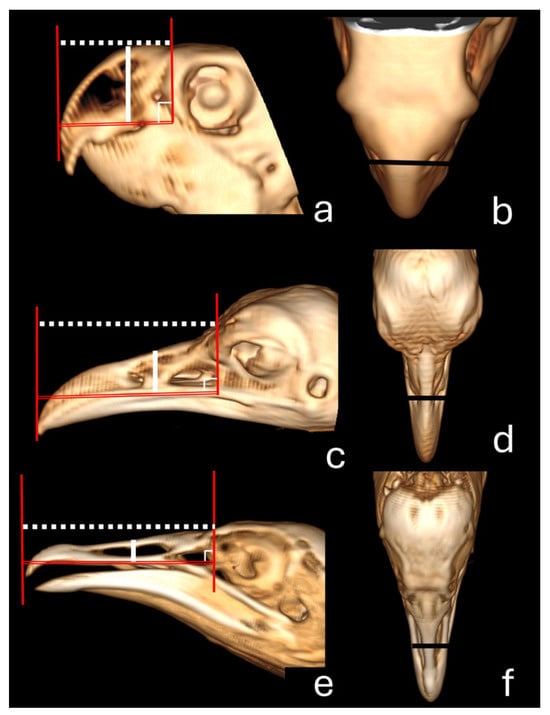
Figure 2.
Three-dimensional tomographic images in the lateral (a,c,e) and dorsal (b,d,f) views of the beaks of parakeet (a,b), red-legged seriema (c,d), and black vulture (e,f). Observe the length (white dotted line) measured from the tip of the maxillary rostrum to the anterior edge of the skull (red lines) and height (solid white line) in the lateral view (a,c,e) and width (solid black line) in the dorsal view (b,d,f).
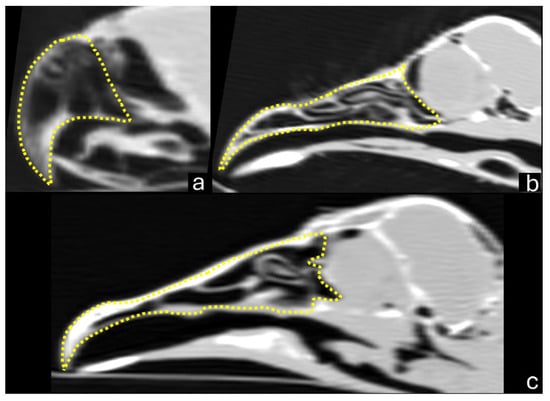
Figure 3.
Sagittal computed tomography images (lung window) demonstrating the area measurement of the beak area (dotted yellow lines) for the parakeet (a), red-legged seriema (b), and black vulture (c).
2.3. Dental Intraoral Scanner
The beaks were scanned using a dental intraoral scanner (Trios 3 Classic; 3Shape; Copenhagen, Denmark). Scanning was performed from the base to the tip of the beak, covering both external and internal surfaces (Figure 4). The images were then reconstructed in 3D form using the 3D Builder (Microsoft Corporation; Redmond, WA, USA). Measurements (length, height, width), similar to those obtained from 3D-CT scans, were conducted using the 3D Builder measure tool (Figure 5).

Figure 4.
Scanning of parakeet (a), red-legged seriema (b), and black vulture (c) beaks with dental intraoral scanner.
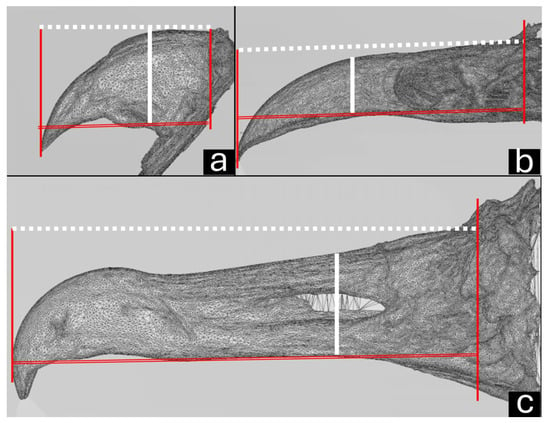
Figure 5.
STL images in the lateral view of parakeet (a), red-legged seriema (b), and black vulture (c) beaks obtained with a dental intraoral scanner. Observe the length (white dotted line) measured from the tip of the maxillary rostrum to the anterior edge of the skull (red lines) and height (solid white line).
2.4. Macroscopic Measurements
The length, height, and width of the upper beak were measured with a caliper using the same anatomical landmarks as those used in the 3D beak measurements.
2.5. Statistical Analysis
After performing the Kolmogorov–Smirnov normality test, a one-way ANOVA was conducted, followed by Bonferroni’s post hoc test to compare measurements taken using CT, the dental intraoral scanner, and the macroscopic method within each species. For the height of the red-legged seriema, a Friedman test followed by Dunn’s test was utilized. Additionally, ANOVA followed by Bonferroni’s post hoc test was applied to compare measurements across species using CT, the dental intraoral scanner, and the macroscopic method, except for 3D height, where the Kruskal–Wallis test followed by Dunn’s test was applied. The Kruskal–Wallis test was used to assess the area in cm2. The significance level adopted was p ≤ 0.05. The statistical analysis was performed using GraphPad Prism version 8.4.2 (GraphPad Software, Inc., San Diego, CA, USA).
3. Results
3.1. Macroscopy, CT, and Dental Intraoral Scanner
Macroscopically, the parakeet beak was short with a hooked upper beak, and the rhamphotheca was light pinkish with some shades of gray. The nares were two round and distinct openings located in the cera, a waxy protuberance between the head and neck (Figure 6a). The red-legged seriema beak was relatively long and had a bright red color rhamphotheca. The upper beak was hooked, and feathers emerged from its base, forming a tuft. The nares were oblong and located laterally (Figure 6b). The black vulture beak was relatively long and had a hooked shape on the upper beak, and the rhamphotheca was mainly black. The tip of the upper beak was curved and lighter in color. The nares were located in the middle third of the beak, perforated and without a septum, and collimated laterally, allowing visibility through them (Figure 6c).

Figure 6.
(a) A parakeet beak, with the naris located in the cera (black arrow). (b) A red-legged seriema beak, with the naris located laterally (white arrow). (c) A black vulture beak, with the perforated naris located in the middle third (white arrow).
In all the species, CT scans identified the external and internal structures of the beaks. The rostrum maxillare, maxilla, nasal bone, frontal bone, and nasal cavity were visualized in the sagittal plane (Figure 7). The parakeet also had its cera and the craniofacial hinge visualized (zona flexoria craniofacialis).
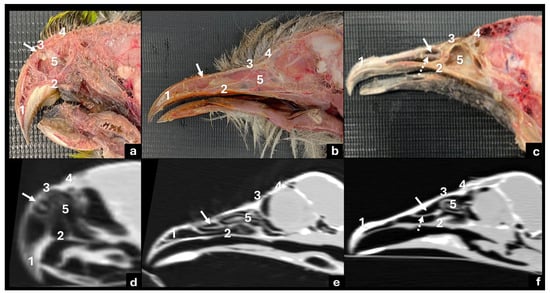
Figure 7.
Macroscopic (a,b,c) and computed tomography images in sagittal view using lung window (d,e,f) of parakeet (a,d), red-legged seriema (b,e) and black vulture (c,f) beaks: 1—rostrum maxillare; 2—maxilla; 3—nasal bone; 4—frontal bone; 5—nasal cavity. White arrow shows naris topography and dotted arrow shows naris base.
The CT measurements of the beaks are presented in Table 1.

Table 1.
Values of the measurements obtained by computed tomography of the upper beaks of the three Neotropical birds, including the length and height in sagittal view, sagittal area (cm2), and the length and height of the nares in three-dimensional view.
Scanning the beaks with a dental intraoral scanner took approximately five minutes. Powder opacification was not required to scan the beaks. Slender feathers that emerged from the beak were removed to avoid interference with scanning. The reproduction matched the original beak tones (Figure 8). The beak measurements from the 3D dental scanner, 3D-CT reconstruction, and macroscopy are presented in Table 2.
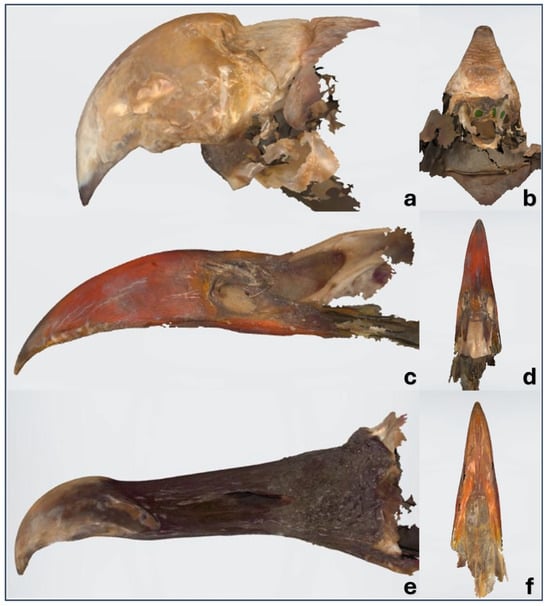
Figure 8.
Images of parakeet (a,b), red-legged seriema (c,d), and black vulture (e,f) beaks obtained with dental intraoral scanner.

Table 2.
Values of measurements obtained by three-dimensional computed tomography (CT), dental intraoral scanner, and macroscopy of upper beaks of three Neotropical birds.
Videos S1 and S2 (Supplementary Material) show the black vulture beak generated in STL using the CT and dental oral scans. Figure 9 shows an example of a rapid prototyping model in resin of a beak generated from a CT scan and a dental intraoral scanner.
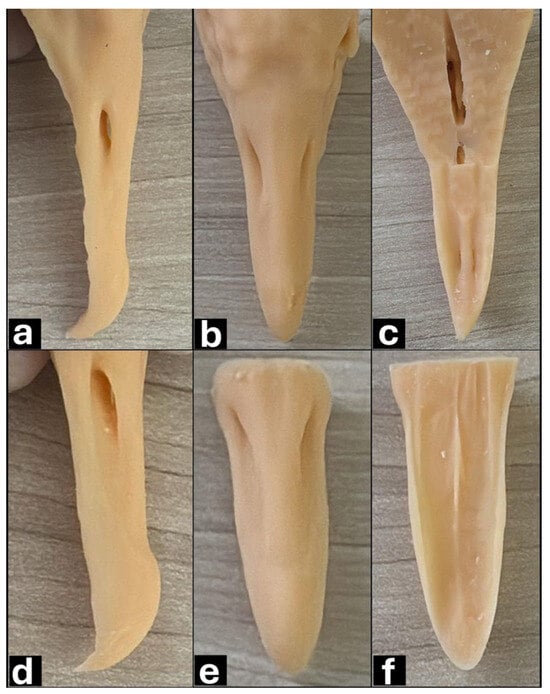
Figure 9.
Rapid prototyping models in resin of black vulture beak generated from CT scan (a,b,c) and dental intraoral scanner (d,e,f). Lateral (a,d), dorsal (b,e), and (c,f) basal views.
3.2. Statistical Analysis
The comparison of beak measurements within each species showed that the dental intraoral scanner differed from both CT and macroscopic analysis in the height and width of the black vulture beaks, as well as the length and height of the parakeet beaks. The dental intraoral scanner also differed from CT in the length of black vulture beaks. The dental intraoral scanner, CT, and macroscopic analysis showed no differences in all measurements for the red-legged seriema beaks and in the width of the parakeet beaks. The statistical differences are presented in Table 3.

Table 3.
Differences between measurements obtained by macroscopy, three-dimensional computed tomography, and dental intraoral scanner in black vulture and parakeet beaks.
The height and length of the nares as well as the area (cm2) of the beaks differed among all species. The area and naris height were higher in the seriema beaks, followed by black vulture, and smaller in parakeet beaks.
4. Discussion
The hypothesis was confirmed as differences in beak measurements between the two imaging methods were verified. It is important to note that the three species selected for the study are commonly encountered in veterinary centers specializing in wildlife, particularly in Neotropical regions. The anatomical information obtained for each beak was used as a basis to evaluate the level of detail provided by the scanning methods. The CT scan provided detailed images of the anatomical structures of the beak, as observed macroscopically, highlighting the unique features of each species. In contrast, the dental intraoral scanner only captured external structures. Performing a CT scan on a living bird requires general anesthesia or deep sedation to prevent movement and stress, in addition to exposing the bird to ionizing radiation [,]. A beak scan can be performed with a dental intraoral scanner with the bird probably under physical restraint or light sedation. With an experienced operator, the scanning process is usually quick, as demonstrated in this study, where scanning took approximately five minutes for each bird’s beak.
The present study utilized a Trios 3 intraoral scanner, which employs the ultrafast optical sectioning technique established according to the confocal laser principle []. The accuracy of the dental scanner can be affected by several factors, including scanner technology (triangulation, confocal microscopy), material surface properties (reflective, matte, and porous), scanning software, light, ambient temperature, scanning strategy, and operator experience, among others [,,]. The Trio 3 scanner has been demonstrated to have good accuracy in several studies [,]. Furthermore, the confocal plane is periodically changed at a certain frequency in this scanner, eliminating the need for the operator to adjust the scanner head to maintain a consistent distance from the object being scanned []. This feature can be advantageous when scanning the beak of a bird that is only under physical restraint.
The color of the rhamphothecas did not hinder the use of the dental scanner, and opacifying them with powder to create an opaque reflective coating before scanning was not necessary []. Additionally, the shape and color of the beaks were not affected during scanning, showing that the intraoral scanner used was sensitive enough to detect in-color impressions, which is an important aspect of the equipment’s ability []. However, testing on other beaks would be necessary, because digital impressions can be influenced by the surface of the object as different materials detect and reflect light differently [].
Beak measurements obtained by CT and the dental intraoral scanner showed some statistical differences in parakeets and black vultures. The dental scanner must have both accuracy (agreement between the measurement result and a true value) and precision (agreement of values obtained by replicate measurements) []. These characteristics were observed mainly in the scanning of the seriemas’ beaks because there was statistical similarity among the three methods of measurement. The differences found in the other species may be related to the difficulty in determining the anatomical landmarks, especially the transition between the beak and skull, due to naris position and the presence of feathers in the cera region in parakeets. This demonstrates that, depending on the height of the lesion, CT is more sensitive than the dental intraoral scanner.
The functional morphology of the beak of each species must be taken into account when developing a prosthesis, considering the anatomical variation among species, as verified in the present study. For example, psittacines like parakeets have a short, curved upper beak with a wide base that fits over the lower beak []. They also have a special joint between the maxilla and the skull (craniofacial hinge) that gives them great mobility and strength in the beak [,]. On the other hand, members of the family Cathartidae, such as black vultures, have evolved specialized respiratory and olfactory systems for detecting and consuming carcasses []. They lack a septum between their nares and have narrow, elongated nares positioned farther back on a long, slender beak, allowing for the suction of soft material without obstruction [,]. The seriema has a strong hooked beak, often compared to the beak of a bird of prey, which is used to tear the flesh of its prey []. Thus, understanding these anatomical features is crucial for designing effective prostheses for birds.
In this regard, the CT scan enables reconstruction while preserving internal anatomical details, if necessary, whereas the intraoral scanner allows for the development of a solid structure. This consideration is crucial, especially when determining the position of the nares based on the bird’s trauma, so that models for larger and more destructive avulsions would be better developed with the aid of CT. On the other hand, the intraoral scanner provides greater surface precision compared to the CT scan, which should also be considered in the quality of the printed prosthesis.
Another key consideration is that birds with injuries in other areas of the body can also benefit from a CT scan. Additionally, from a practitioner’s perspective, if a CT scan has already been performed as part of the diagnostic process, the dental intraoral scan will only be used if the practitioner has the necessary equipment. It is important to note that several studies have successfully developed beak prostheses using solely CT scan images [,,].
The details of beak thickness are important when fixing the prosthesis, for example, using screws. CT scans can help determine the optimal screw location and thickness, which is not possible with an intraoral scanner alone. Therefore, combining the capabilities of CT and an intraoral scanner would be more advantageous for virtually simulating the procedure before implementation compared to using either method independently.
The major limitation of this study was the use of only three bird species. Other species must be evaluated because the color and shape of the beak can influence the quality of dental intraoral scans. However, the findings from this study can be useful for future prosthetic research on bird beaks.
5. Conclusions
The two scanning techniques, CT and a dental intraoral scanner, enabled the assessment and creation of a three-dimensional model of the beaks of three Neotropical birds: parakeets, red-legged seriemas, and black vultures. Both techniques are effective, but CT provides more detailed information. The combination of both methods would be ideal for developing and applying a beak prosthesis.
Supplementary Materials
The following supporting information can be downloaded at: https://www.mdpi.com/article/10.3390/vetsci12040331/s1, Video S1: black-headed vulture beak generated in STL using the CT; Video S2: black-headed vulture beak generated in STL using a dental oral scan.
Author Contributions
Conceptualization, G.C.d.C., S.C.R., R.A.J. and J.P.d.S.; methodology, G.C.d.C., S.C.R., R.A.J., J.P.d.S., D.S.d.S., M.C.R.C., R.S.I. and B.C.C.; software, G.C.d.C., S.C.R., R.A.J., J.P.d.S., M.C.R.C. and B.C.C.; validation, G.C.d.C., S.C.R., R.A.J., J.P.d.S., D.S.d.S., M.C.R.C., R.S.I. and B.C.C.; investigation, G.C.d.C., S.C.R., R.A.J., J.P.d.S., D.S.d.S., M.C.R.C. and B.C.C.; resources, G.C.d.C., S.C.R., R.A.J., J.P.d.S. and D.S.d.S.; data curation: G.C.d.C., S.C.R., R.A.J. and J.P.d.S.; writing—original draft preparation, G.C.d.C. and S.C.R.; writing—review and editing, G.C.d.C., S.C.R., R.A.J., J.P.d.S., D.S.d.S., M.C.R.C., R.S.I. and B.C.C.; visualization, G.C.d.C., S.C.R., R.A.J., J.P.d.S., D.S.d.S., M.C.R.C., R.S.I. and B.C.C.; supervision, S.C.R., R.A.J. and J.P.d.S. All authors have read and agreed to the published version of the manuscript.
Funding
This research received no external funding.
Institutional Review Board Statement
The animal study protocol was approved by the Institutional Ethics Committee for the Use of Animals (CEUA—no. 0541/2023) on 1 May 2023 at the School of Veterinary Medicine and Animal Science, UNESP, Botucatu Campus.
Informed Consent Statement
Not applicable.
Data Availability Statement
The data presented in this study are available on request from the corresponding author.
Acknowledgments
We want to thank FINEP (Financiadora de Estudos e Projetos; Grant 01.12.0530.00); Capes (Coordination for the Improvement of Higher Education Personnel)—Code 001; and CNPq (Coordination for the Improvement of Higher Education Personnel—PQ 305813/2023-4).
Conflicts of Interest
The authors declare no conflicts of interest.
Abbreviations
The following abbreviations are used in this manuscript:
| CT | Computed tomography |
| 3D | Three-dimensional |
References
- Ritchie, B.W.; Harrison, G.J.; Harisson, L.R. Avian Medicine: Principles and Application; Wingers Publishing: Lake Worth, FL, USA, 1994. [Google Scholar]
- Worell, A.B. Dermatological conditions affecting the beak, claws, and feet of captive avian species. Vet. Clin. N. Am. Exot. Anim. Pract. 2013, 16, 777–799. [Google Scholar] [CrossRef]
- Fecchio, R.S. Beakistry. In Zoo and Wild Animal; Emily, P.P., Eisner, E.R., Eds.; Wiley Blackwell: Hoboken, NJ, USA, 2021; pp. 99–117. [Google Scholar]
- Coles, B. Essentials of Avian Medicine and Surgery, 3rd ed.; Blackwell Publishing: Oxford, UK, 2008. [Google Scholar]
- Wheler, C.L. Orthopedic conditions of the avian head. Vet. Clin. N. Am. Exot. Anim. Pract. 2002, 5, 83–95. [Google Scholar] [CrossRef]
- Doneley, B. Avian Medicine and Surgery in Practice; Manson Publishing Ltd.: London, UK, 2010. [Google Scholar]
- Huynh, M.; González, M.S.; Beaufrére, H. Avian skull orthopedics. Vet. Clin. N. Am. Exot. Anim. Pract. 2019, 22, 253–283. [Google Scholar] [CrossRef] [PubMed]
- Speer, B.; Powers, L.V. Anatomy and disorders of the beak and oral cavity of birds. Vet. Clin. N. Am. Exot. Anim. Pract. 2016, 19, 707–736. [Google Scholar] [CrossRef] [PubMed]
- Morris, P.J.; Weigel, J.P. Methacrylate beak prosthesis in a marabou stork (Leptoptilos crumeniferus). J. Assoc. Avian Vet. 1990, 4, 103–106. [Google Scholar] [CrossRef]
- Rong, C.; Changlin, D.; Guodong, W.; Meirong, L.; Shujie, W.; Hongyi, L.; Menglin, Z.; Chengping, L. Comparison of 3d-printed titanium alloy and polyether ether ketone prosthetic beaks for an injured red-crowned crane (Grus japonensis). J. Avian Med. Surg. 2022, 35, 445–450. [Google Scholar] [CrossRef]
- Kim, H.J.; Cho, C.; Kim, K.T. Application of 3D-printed prosthetic lower beak in an Oriental stork (Ciconia boyciana). J. Vet. Med. Sci. 2023, 85, 1190–1194. [Google Scholar] [CrossRef] [PubMed]
- Krautwald-Junghanns, M.E.; Kostka, V.M.; Dörsch, B. Comparative studies on the diagnostic value of conventional radiography and computed tomography in evaluating the heads of psittacine and raptorial birds. J. Avian Med. Surg. 1998, 12, 149–157. [Google Scholar]
- Mangano, F.; Gandolfi, A.; Luongo, G.; Logozzo, S. Intraoral scanners in dentistry: A review of the current literature. BMC Oral. Health 2017, 17, 149. [Google Scholar] [CrossRef]
- Hwang, H.H.; Chou, C.; Chen, Y.; Yao, C.J. An overview of digital intraoral scanners: Past, present and future- from an orthodontic perspective. Taiwan. J. Orthod. 2018, 30, 148–162. [Google Scholar] [CrossRef]
- Nikoyan, L.; Patel, R. Intraoral scanner, three-dimensional imaging, and three-dimensional printing in the dental office. Dent. Clin. N. Am. 2020, 64, 365–378. [Google Scholar] [CrossRef] [PubMed]
- Gumpenberger, M.; Henninger, W. The use of computed tomography in avian and reptile medicine. Semin. Avian Exot. Pet. Med. 2001, 10, 174–180. [Google Scholar] [CrossRef]
- Greco, A.; Meomartino, L.; Gnudi, G.; Brunetti, A.; Di Giancamillo, M. Imaging techniques in veterinary medicine. Part II: Computed tomography, magnetic resonance imaging, nuclear medicine. Eur. J. Radiol. Open. 2022, 10, 100467. [Google Scholar] [CrossRef] [PubMed]
- Aswani, K.; Wankhade, S.; Khalikar, A.; Deogade, S. Accuracy of an intraoral digital impression: A review. J. Indian Prosthodont. Soc. 2020, 20, 27–37. [Google Scholar] [CrossRef]
- Shah, N.; Thakur, M.; Gill, S.; Shetty, O.; Alqahtani, N.M.; Al-Qarni, M.A.; Alqahtani, S.M.; Elagib, M.F.A.; Chaturvedi, S. Validation of digital impressions’ accuracy obtained using intraoral and extraoral scanners: A systematic review. J. Clin. Med. 2023, 12, 5833. [Google Scholar] [CrossRef] [PubMed]
- Alkadi, L.A. Comprehensive review of factors that influence the accuracy of intraoral scanners. Diagnostics 2023, 13, 3291. [Google Scholar] [CrossRef]
- Winkler, J.; Gkantidis, N. Trueness and precision of intraoral scanners in the maxillary dental arch: An in vivo analysis. Sci. Rep. 2020, 10, 1172. [Google Scholar] [CrossRef]
- Amornvit, P.; Rokaya, D.; Sanohkan, S. Comparison of accuracy of current ten intraoral scanners. Biomed. Res. Int. 2021, 2021, 2673040. [Google Scholar] [CrossRef]
- Grespan, A.; Raso, T.F. Psittaciformes (Araras, Papagaios, Periquitos, Calopsitas e Cacatuas). In Tratado de Animais Selvagens: Medicina Veterinária; Cubas, Z.S., Silva, J.C.R., Catão-Dias, J.L., Eds.; Roca: São Paulo, Brazil, 2014; pp. 550–589. [Google Scholar]
- Harcourt-Brown, N.H. Anatomy and physiology. In BSAVA Manual of Psittacine Birds; Harcourt-Brown, N.H., Chitty, J., Eds.; British Small Animal Veterinary Association: Glouster, UK, 2005; pp. 7–21. [Google Scholar]
- Stager, K.E. The role of olfaction in food location by the turkey vulture (Cathartes aura). Contrib. Sci. 1964, 81, 1–63. [Google Scholar]
- Bang, B.G. The nasal organs of the black and turkey vultures; A comparative study of the cathartid species Coragyps atratus atratus and Cathartes aura septentrionalis (with notes on Cathartes aura falklandica, pseudogyps bengalensis, and Neophron percnopterus). J. Morphol. 1964, 115, 153–183. [Google Scholar] [CrossRef]
- Jackson, J.A. American black vulture. In Handbook of North American Birds; Palmer, R., Ed.; Yale University Press: New Haven, CT, USA, 1998; pp. 11–24. [Google Scholar]
- Sick, H. Ornitologia Brasileira; Editora Universidade de Brasília: Brasília, Brazil, 1984. [Google Scholar]
- Fecchio, R.S.; Seki, Y.; Bodde, S.G.; Gomes, M.S.; Kolososki, J.; Rossi, J.L., Jr.; Gioso, M.A.; Meyers, M.A. Mechanical behavior of prosthesis in Toucan beak (Ramphastos toco). Mat. Sci. Eng. C 2010, 30, 460–464. [Google Scholar] [CrossRef]
- Song, C.; Wang, A.; Wu, Z.; Chen, Z.; Yang, Y.; Wang, D. The design and manufacturing of a titanium alloy beak for Grus japonensis using additive manufacturing. Mater. Des. 2017, 17, 410–416. [Google Scholar] [CrossRef]
- Xie, S.; Cai, B.; Rasidi, E.; Yen, C.C.; Hsu, C.D.; Chow, W.T.; De Busscher, V.; Hsu, L.C. The use of a 3D-printed prosthesis in a Great Hornbill (Buceros bicornis) with squamous cell carcinoma of the casque. PLoS ONE 2019, 14, e0220922. [Google Scholar] [CrossRef] [PubMed]
Disclaimer/Publisher’s Note: The statements, opinions and data contained in all publications are solely those of the individual author(s) and contributor(s) and not of MDPI and/or the editor(s). MDPI and/or the editor(s) disclaim responsibility for any injury to people or property resulting from any ideas, methods, instructions or products referred to in the content. |
© 2025 by the authors. Licensee MDPI, Basel, Switzerland. This article is an open access article distributed under the terms and conditions of the Creative Commons Attribution (CC BY) license (https://creativecommons.org/licenses/by/4.0/).